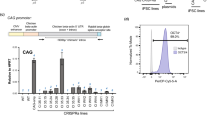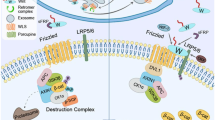Abstract
Purinergic signaling mediated by P2 receptors (P2Rs) plays important roles in embryonic and stem cell development. However, how it mediates Ca2+ signals in human embryonic stem cells (hESCs) and derived cardiovascular progenitor cells (CVPCs) remains unclear. Here, we aimed to determine the role of P2Rs in mediating Ca2+ mobilizations of these cells. hESCs were induced to differentiate into CVPCs by our recently established methods. Gene expression of P2Rs and inositol 1,4,5-trisphosphate receptors (IP3Rs) was analyzed by quantitative/RT-PCR. IP3R3 knockdown (KD) or IP3R2 knockout (KO) hESCs were established by shRNA- or TALEN-mediated gene manipulations, respectively. Confocal imaging revealed that Ca2+ responses in CVPCs to ATP and UTP were more sensitive and stronger than those in hESCs. Consistently, the gene expression levels of most P2YRs except P2Y1 were increased in CVPCs. Suramin or PPADS blocked ATP-induced Ca2+ transients in hESCs but only partially inhibited those in CVPCs. Moreover, the P2Y1 receptor-specific antagonist MRS2279 abolished most ATP-induced Ca2+ signals in hESCs but not in CVPCs. P2Y1 receptor-specific agonist MRS2365 induced Ca2+ transients only in hESCs but not in CVPCs. Furthermore, IP3R2KO but not IP3R3KD decreased the proportion of hESCs responding to MRS2365. In contrast, both IP3R2 and IP3R3 contributed to UTP-induced Ca2+ responses while ATP-induced Ca2+ responses were more dependent on IP3R2 in the CVPCs. In conclusion, a predominant role of P2Y1 receptors in hESCs and a transition of P2Y-IP3R coupling in derived CVPCs are responsible for the differential Ca2+ mobilization between these cells.








Similar content being viewed by others
References
Yang L, Soonpaa MH, Adler ED, Roepke TK, Kattman SJ et al (2008) Human cardiovascular progenitor cells develop from a KDR+ embryonic-stem-cell-derived population. Nature 453(7194):524–528
Birket MJ, Ribeiro MC, Verkerk AO, Ward D, Leitoguinho AR et al (2015) Expansion and patterning of cardiovascular progenitors derived from human pluripotent stem cells. Nat Biotechnol 33(9):970–979
Bu L, Jiang X, Martin-Puig S, Caron L, Zhu S et al (2009) Human ISL1 heart progenitors generate diverse multipotent cardiovascular cell lineages. Nature 460(7251):113–117
Cao N, Liang H, Huang J, Wang J, Chen Y et al (2013) Highly efficient induction and long-term maintenance of multipotent cardiovascular progenitors from human pluripotent stem cells under defined conditions. Cell Res 23(9):1119–1132
Birket MJ, Mummery CL (2015) Pluripotent stem cell derived cardiovascular progenitors—a developmental perspective. Dev Biol 400(2):169–179
Pouton CW, Haynes JM (2007) Embryonic stem cells as a source of models for drug discovery. Nat Rev Drug Discov 6(8):605–616
Barbaric I, Gokhale PJ, Andrews PW (2010) High-content screening of small compounds on human embryonic stem cells. Biochem Soc Trans 38(4):1046–1050
Jung EM, Choi YU, Kang HS, Yang H, Hong EJ et al (2015) Evaluation of developmental toxicity using undifferentiated human embryonic stem cells. J Appl Toxicol 35(2):205–218
Jiang Y, Wang D, Zhang G, Wang G, Tong J et al (2015) Disruption of cardiogenesis in human embryonic stem cells exposed to trichloroethylene. Environ Toxicol. doi:10.1002/tox.22142
Blin G, Nury D, Stefanovic S, Neri T, Guillevic O et al (2010) A purified population of multipotent cardiovascular progenitors derived from primate pluripotent stem cells engrafts in postmyocardial infarcted nonhuman primates. J Clin Invest 120(4):1125–1139
Passier R, van Laake LW, Mummery CL (2008) Stem-cell-based therapy and lessons from the heart. Nature 453(7193):322–329
Kunapuli SP, Daniel JL (1998) P2 receptor subtypes in the cardiovascular system. Biochem J 336(Pt 3):513–523
Burnstock G, Pelleg A (2015) Cardiac purinergic signalling in health and disease. Purinergic Signalling 11(1):1–46
Erlinge D, Burnstock G (2008) P2 receptors in cardiovascular regulation and disease. Purinergic Signalling 4(1):1–20
Burnstock G (2014) Purinergic signalling: from discovery to current developments. Exp Physiol 99(1):16–34
Burnstock G, Ulrich H (2011) Purinergic signaling in embryonic and stem cell development. Cell Mol Life Sci 68(8):1369–1394
Li LF, Xiang C, Qin KR (2015) Modeling of TRPV4-C1-mediated calcium signaling in vascular endothelial cells induced by fluid shear stress and ATP. Biomech Model Mechanobiol 14(5):979–993
Nejime N, Tanaka N, Yoshihara R, Kagota S, Yoshikawa N et al (2008) Effect of P2 receptor on the intracellular calcium increase by cancer cells in human umbilical vein endothelial cells. Naunyn Schmiedeberg’s Arch Pharmacol 377(4-6):429–436
Govindan S, Taylor CW (2012) P2Y receptor subtypes evoke different Ca2+ signals in cultured aortic smooth muscle cells. Purinergic Signalling 8(4):763–777
Kumari R, Goh G, Ng LL, Boarder MR (2003) ATP and UTP responses of cultured rat aortic smooth muscle cells revisited: dominance of P2Y2 receptors. Br J Pharmacol 140(7):1169–1176
Dolmatova E, Spagnol G, Boassa D, Baum JR, Keith K et al (2012) Cardiomyocyte ATP release through pannexin 1 aids in early fibroblast activation. Am J Physiol Heart Circ Physiol 303(10):H1208–1218
Cosentino S, Banfi C, Burbiel JC, Luo H, Tremoli E et al (2012) Cardiomyocyte death induced by ischaemic/hypoxic stress is differentially affected by distinct purinergic P2 receptors. J Cell Mol Med 16(5):1074–1084
Mazrouei S, Sharifpanah F, Bekhite MM, Figulla HR, Sauer H et al (2015) Cardiomyogenesis of embryonic stem cells upon purinergic receptor activation by ADP and ATP. Purinergic Signalling. 11(4):491-506
Heo JS, Han HJ (2006) ATP stimulates mouse embryonic stem cell proliferation via protein kinase C, phosphatidylinositol 3-kinase/Akt, and mitogen-activated protein kinase signaling pathways. Stem Cells 24(12):2637–2648
Ferreira-Martins J, Rondon-Clavo C, Tugal D, Korn JA, Rizzi R et al (2009) Spontaneous calcium oscillations regulate human cardiac progenitor cell growth. Circ Res 105(8):764–774
Ermakov A, Pells S, Freile P, Ganeva VV, Wildenhain J et al (2012) A role for intracellular calcium downstream of G-protein signaling in undifferentiated human embryonic stem cell culture. Stem Cell Res 9(3):171–184
Apati A, Paszty K, Hegedus L, Kolacsek O, Orban TI et al (2013) Characterization of calcium signals in human embryonic stem cells and in their differentiated offspring by a stably integrated calcium indicator protein. Cell Signal 25(4):752–759
von Kugelgen I (2006) Pharmacological profiles of cloned mammalian P2Y-receptor subtypes. Pharmacol Ther 110(3):415–432
Mikoshiba K (2007) IP3 receptor/Ca2+ channel: from discovery to new signaling concepts. J Neurochem 102(5):1426–1446
Foskett JK, White C, Cheung KH, Mak DO (2007) Inositol trisphosphate receptor Ca2+ release channels. Physiol Rev 87(2):593–658
Nakazawa M, Uchida K, Aramaki M, Kodo K, Yamagishi C et al (2011) Inositol 1,4,5-trisphosphate receptors are essential for the development of the second heart field. J Mol Cell Cardiol 51(1):58–66
Woodcock EA, Matkovich SJ (2005) Ins(1,4,5)P3 receptors and inositol phosphates in the heart-evolutionary artefacts or active signal transducers? Pharmacol Ther 107(2):240–251
Yoo SH (2012) Chromogranins and inositol 1,4,5-trisphosphate-dependent Ca(2+)-signaling in cardiomyopathy and heart failure. Curr Med Chem 19(24):4068–4073
Cao N, Liang H, Yang HT (2015) Generation, expansion, and differentiation of cardiovascular progenitor cells from human pluripotent stem cells. Methods Mol Biol 1212:113–125
He JQ, Ma Y, Lee Y, Thomson JA, Kamp TJ (2003) Human embryonic stem cells develop into multiple types of cardiac myocytes: action potential characterization. Circ Res 93(1):32–39
Li K, Zhang W, Liu J, Wang W, Xie W et al (2009) Flash Sniper: automated detection and analysis of mitochondrial superoxide flash. Biophys J 96(3):531a–532a
Hattori M, Suzuki AZ, Higo T, Miyauchi H, Michikawa T et al (2004) Distinct roles of inositol 1,4,5-trisphosphate receptor types 1 and 3 in Ca2+ signaling. J Biol Chem 279(12):11967–11975
Ouyang K, Leandro Gomez-Amaro R, Stachura DL, Tang H, Peng X et al (2014) Loss of IP3R-dependent Ca2+ signalling in thymocytes leads to aberrant development and acute lymphoblastic leukemia. Nat Commun 5:4814
Abbracchio MP, Burnstock G, Boeynaems JM, Barnard EA, Boyer JL et al (2006) International Union of Pharmacology LVIII: update on the P2Y G protein-coupled nucleotide receptors: from molecular mechanisms and pathophysiology to therapy. Pharmacol Rev 58(3):281–341
Zhang S, Fritz N, Ibarra C, Uhlen P (2011) Inositol 1,4,5-trisphosphate receptor subtype-specific regulation of calcium oscillations. Neurochem Res 36(7):1175–1185
James G, Butt AM (2002) P2Y and P2X purinoceptor mediated Ca2+ signalling in glial cell pathology in the central nervous system. Eur J Pharmacol 447(2-3):247–260
von Kugelgen I, Wetter A (2000) Molecular pharmacology of P2Y-receptors. Naunyn Schmiedeberg’s Arch Pharmacol 362(4-5):310–323
Yanagida E, Shoji S, Hirayama Y, Yoshikawa F, Otsu K et al (2004) Functional expression of Ca2+ signaling pathways in mouse embryonic stem cells. Cell Calcium 36(2):135–146
Gur S, Hellstrom WJ (2009) Activation of P2Y1 and P2Y2 nucleotide receptors by adenosine 5′-triphosphate analogues augmented nerve-mediated relaxation of human corpus cavernosum. Can Urol Assoc J 3(4):314–318
Shen JB, Yang R, Pappano A, Liang BT (2014) Cardiac P2X purinergic receptors as a new pathway for increasing Na(+) entry in cardiac myocytes. Am J Physiol Heart Circ Physiol 307(10):H1469–1477
Govindan S, Taylor EJ, Taylor CW (2010) Ca(2+) signalling by P2Y receptors in cultured rat aortic smooth muscle cells. Br J Pharmacol 160(8):1953–1962
Hough SR, Laslett AL, Grimmond SB, Kolle G, Pera MF (2009) A continuum of cell states spans pluripotency and lineage commitment in human embryonic stem cells. PLoS One 4(11):e7708
Khaira SK, Pouton CW, Haynes JM (2009) P2X2, P2X4 and P2Y1 receptors elevate intracellular Ca2+ in mouse embryonic stem cell-derived GABAergic neurons. Br J Pharmacol 158(8):1922–1931
Mironneau J, Coussin F, Morel JL, Barbot C, Jeyakumar LH et al (2001) Calcium signalling through nucleotide receptor P2X1 in rat portal vein myocytes. J Physiol 536(Pt 2):339–350
Skerjanc IS (1999) Cardiac and skeletal muscle development in P19 embryonal carcinoma cells. Trends Cardiovasc Med 9(5):139–143
Resende RR, Britto LR, Ulrich H (2008) Pharmacological properties of purinergic receptors and their effects on proliferation and induction of neuronal differentiation of P19 embryonal carcinoma cells. Int J Dev Neurosci 26(7):763–777
Communi D, Robaye B, Boeynaems JM (1999) Pharmacological characterization of the human P2Y11 receptor. Br J Pharmacol 128(6):1199–1206
Bansaghi S, Golenar T, Madesh M, Csordas G, RamachandraRao S et al (2014) Isoform- and species-specific control of inositol 1,4,5-trisphosphate (IP3) receptors by reactive oxygen species. J Biol Chem 289(12):8170–8181
Acknowledgments
This work was supported by the grants from the National Natural Science of China Grants (Nos. 31030050 and 81520108004 to HTY, No. 31401167 to MZ); the Strategic Priority Research Program of CAS (No. XDA01020204 to HTY); the National Basic Research Program of China (No. 2014CB965100 to HTY); the National Science and Technology Major Project (No. 2012ZX09501001 to HTY); and the Major Program of Development Fund for Shanghai Zhangjiang National Innovation Demonstration Zone (No. ZJ2014-ZD-002 to HTY). We thank WiCell Research Institute for providing the H7 and H9 hESCs, and Dr. Heping Cheng (Peking University, Beijing, China) for providing the Flash Sniper software and for constructive discussion.
Author information
Authors and Affiliations
Corresponding author
Ethics declarations
Conflict of interest
The authors declare that they have no conflicts of interest.
Additional information
Jijun Huang and Min Zhang are joint first co-authors.
Electronic supplementary material
Below is the link to the electronic supplementary material.
ESM 1
(PDF 486 kb)
Rights and permissions
About this article
Cite this article
Huang, J., Zhang, M., Zhang, P. et al. Coupling switch of P2Y-IP3 receptors mediates differential Ca2+ signaling in human embryonic stem cells and derived cardiovascular progenitor cells. Purinergic Signalling 12, 465–478 (2016). https://doi.org/10.1007/s11302-016-9512-9
Received:
Accepted:
Published:
Issue Date:
DOI: https://doi.org/10.1007/s11302-016-9512-9




